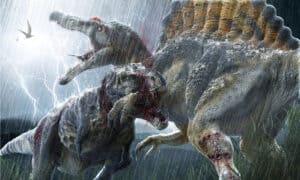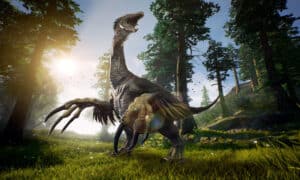The dinosaur age is known for its massive fearsome beasts, and that includes sea dinosaurs. Dinosaurs are reptiles from the clade Dinosauria. From the most famous T-Rex to the massive brachiosaurus, they were some of the most diverse and unusual animals to walk the earth. But what about those that lived in the sea?
Although some dinosaurs entered the sea to hunt for prey – such as the spinosaurus – there are no dinosaurs known to have lived in the sea. Instead, many of what we think of as “dinosaurs” in the sea were actually large marine reptiles.
While some of the better-known ones are the mosasaurs and plesiosaurs, some of the largest are ichthyosaurs which could reach incredible lengths. So join us as we discover the largest sea “dinosaur” in history!
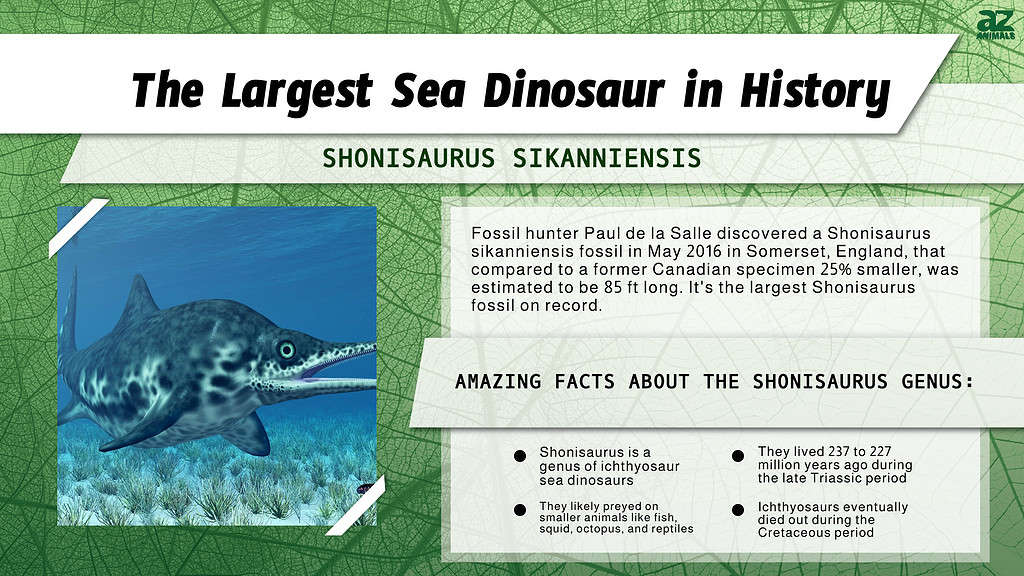
About Ichthyosaurs
Ichthyosaurs are extinct sea dinosaurs, marine reptiles from the order Ichthyosauria and lived between 250 and 90 million years ago. There are more than 50 known genera within Ichthyosauria, comprising of around more than 100 known species, and their size varies widely. They initially evolved from land reptiles that returned to the sea. The smallest specimens were only around 1 foot long while the largest water dinosaur was more than 80 feet long. However, they were some of the top predators in the water during the Late Triassic and Early Jurassic periods.
While the earliest ichthyosaurs were somewhat eel-like, they quickly evolved to resemble fish or dolphins. They had short heads and necks with elongated snouts and their limbs had fully evolved into flippers. Like dolphins and whales, ichthyosaurs lacked gills and breathed air instead.
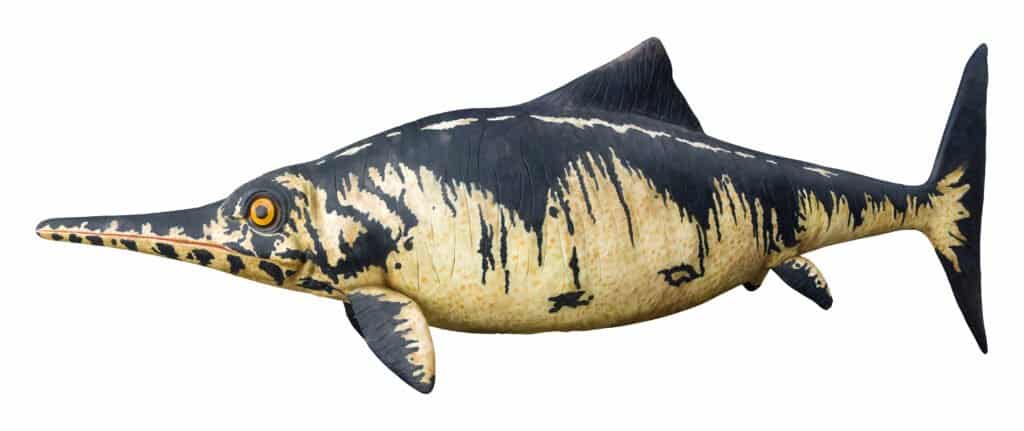
Ichthyosaurs were large marine reptiles with elongated snouts.
©YuRi Photolife/Shutterstock.com
They also gave birth to live young rather than laying eggs. Ichthyosaurs also had large, prominent eyes. This suggests that they were adapted to hunting at great depths in murky water with little light. In fact, they had the largest eyes and eye sockets of all known vertebrates.
Some ichthyosaurs had small teeth which they used to catch smaller prey such as fish and octopus. However, others had large blade-like teeth which would be used to prey on larger animals. Thalattoarchon in particular was a 28-foot-long apex predator with large teeth that had two cutting edges on them. Thalattoarchon is best known for its ability to prey on animals that were a similar size to their own.
The Largest Sea Dinosaurs in History
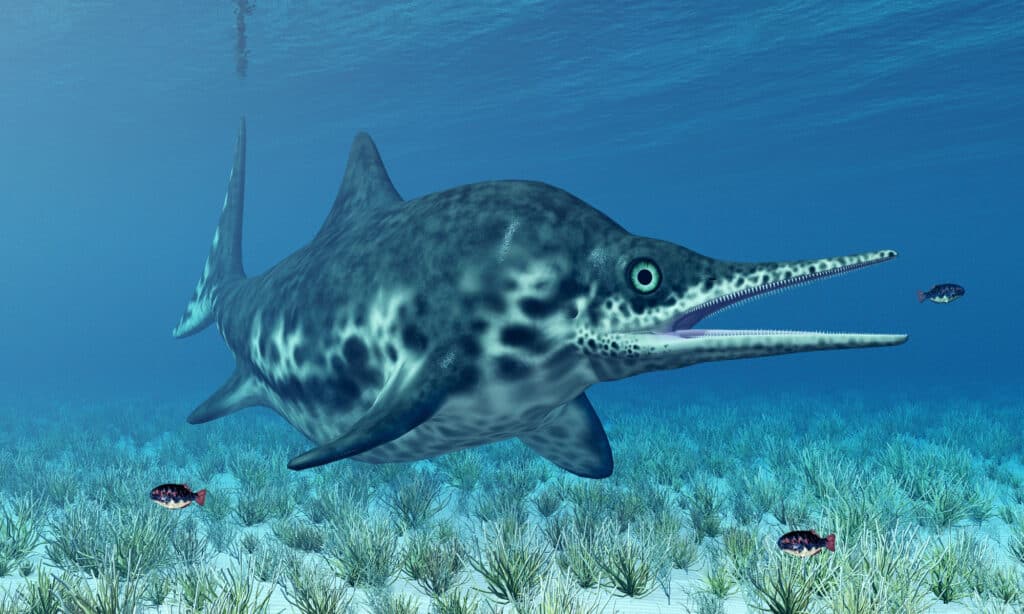
is believed to be the largest sea dinosaur at 85 ft.
©Michael Rosskothen/Shutterstock.com
The largest sea dinosaurs to exist during the age of the dinosaurs was an incredible 85 feet long and is believed to be Shonisaurus sikanniensis. The gigantic fossil was discovered in Somerset, England by fossil hunter Paul de la Salle in May 2016. De la Salle was searching the beach when he came across some huge pieces of fossilized bone.
There were five pieces in total which formed a bone 3.2 feet long. Unsure of quite what he had discovered, he sent pictures to experts Dean Lomax and Judy Massare who confirmed it to be the lower jaw of a massive ichthyosaur.
Although it was impossible to initially tell which species the gigantic beast had been, Lomax and Massare traveled to Canada to compare the bone with that of another large ichthyosaur that had been unearthed in 2004. This was an almost complete fossilized skeleton of a 69-foot-long Shonisaurus sikanniensis (previously the longest).
By comparing the two, they determined that it was almost certainly the same species. However, the jaw bone from England was 25% larger than that of the skeleton in Canada. This allowed them to make a reasonably accurate estimation of what size the animal would have been.
This newest find remains the largest that has ever been found in the UK which seems to be a hotspot for large ichthyosaur bones. However, in 2021 the most complete ichthyosaur skeleton found in the country was unearthed.
While nowhere near as big as de la Salle’s find, the 66-foot-long skeleton is yet another different species – Temnodontosaurus trigonodon. No one knows just how large ichthyosaurs really were. Therefore, as more skeletons continue to be discovered who knows if there is an even bigger find yet to come.
About Shonisaurus
Shonisaurus is a genus of ichthyosaur sea dinosaurs. It contains some of the largest extinct marine reptiles on earth, as we’ve just established. They lived 237 to 227 million years ago during the late Triassic period. Shonisauruses – including Shonisaurus sikanniensis – tended to have a longer snout and longer, thinner flippers than most of the other ichthyosaurs. They also had slimmer and more slender bodies than some of the others.
Shonisaurus teeth were mostly always in teeth sockets. This meant they were fused to the jaw bone, rather than being situated in a groove. Surprisingly, they had teeth only at the very front end of their long snouts. While the teeth that they had were likely sharp and pointy, evidence suggests that despite their size they didn’t prey on larger animals like we might expect.
Although there were certainly many ichthyosaurs that filled that role, Shonisaurus wasn’t one of them. Instead, these water dinosaurs are more likely to have preyed on smaller animals – such as small to medium-sized fish, squid, octopus, and other small reptiles.
What Happened to the Ichthyosaurs?
Ichthyosaurs are hailed for reaching incredibly large sizes for sea dinosaurs, much quicker than other dinosaurs and extinct reptiles. Shonisaurus continued to hold the title as the largest right the way through the Late Triassic period – which is when the ichthyosaurs were at their peak. However, evidence suggests that they disappeared from the timeline by the beginning of the Jurassic Period. The ichthyosaurs as a group continued to be abundant through the Early Jurassic period. However, they began to decline during the Late Jurassic period. Far fewer fossils have been found that date back to this period, and evidence suggests that they were not quite as diverse – or as large. By this time the largest was only around 13 feet long.
Ichthyosaurs eventually died out during the Cretaceous period. One theory about their extinction puts it down to increased competition from mosasaurs and plesiosaurs. However, regardless of the reason, ichthyosaurs remain one of the largest and most unique animals to have ever lived in the ocean.
The photo featured at the top of this post is © Michael Rosskothen/Shutterstock.com
Thank you for reading! Have some feedback for us? Contact the AZ Animals editorial team.



